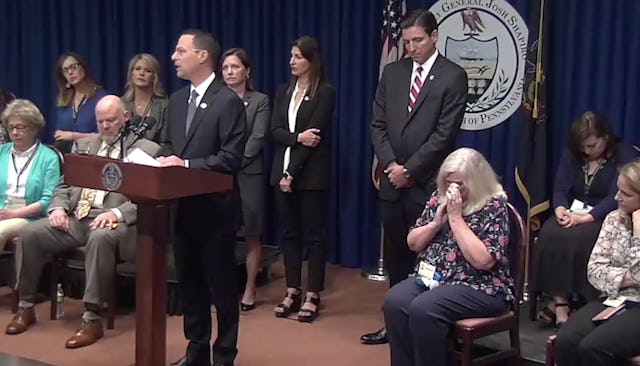Pennsylvania Catholic Church Hid Sexual Abuse Of Over 1,000 Children By 300 Priests

Catholic Church hid sexual abuse of more than 1,000 kids
Leaders in the Roman Catholic Church covered up the child sexual abuse of more than 300 priests in Pennsylvania, a new report from a grand jury shows. The priests abused more than 1,000 children, and their crimes were hidden for more than 70 years. According to Pennsylvania’s attorney general, their investigation is the largest and most comprehensive on the church’s sexual abuse by a U.S. state.
“Priests were raping little boys and girls, and the men of God who were responsible for them not only did nothing; they hid it all. For decades,” the grand jury wrote in its report. The report, which investigated six of the eight Catholic dioceses in the state of Pennsylvania, showed that church leaders routinely pushed victims not to report the abuse and police not to investigate the heinous crimes. Attorney General Josh Shapiro and his legal team conducted the investigation. “They protected their institution at all costs. As the grand jury found, the church showed complete disdain for victims,” Shapiro said.
“Over one thousand child victims were identifiable, from the church’s own records. We believe that the real number – of children whose records were lost, or who were afraid ever to come forward – is in the thousands,” the grand jury wrote. “Most of the victims were boys, but there were girls too. Some were teens; many were prepubescent. But all of them were brushed aside, in every part of the state, by church leaders who preferred to protect the abusers and their institution above all.”
The grand jury detailed some of the specific attacks, but they were all horrific and all criminal. Not only did the church treat these unforgivable crimes as normal behavior, but church officials did everything in their power to silence victims and had “a playbook for concealing the truth,” the grand jury noted in its report.
First, they would downplay the crimes by calling the rapes “inappropriate contact,” and then they’d have other priests ask “inadequate questions” instead of having trained investigators review the alleged crimes. If they moved the accused child molester to another diocese, they would lie to the community. “Tell his parishioners that he is on ‘sick leave,’ or suffering from ‘nervous exhaustion.’ Or say nothing at all,” the report said.
The grand jury said that the Catholic Church decided that “even if a priest is raping children, keep providing him housing and living expenses, although he may be using these resources to facilitate more sexual assaults.” And that “if a predator’s conduct becomes known to the community, don’t remove him from the priesthood to ensure that no more children will be victimized. Instead, transfer him to a new location where no one will know he is a child abuser,” the report said.
The grand jury said kids “were raped in places of worship, in schools, and in diocesan-owned vehicles, and were groomed through diocesan programs and retreats.” Perhaps the most disturbing detail of the investigation involved a ring of alleged rapist priests who gave their victims gold crosses to wear, so they were marked. “They were a visible designation that these children were victims of sexual abuse,” the grand jury wrote. “They were a signal to other predators that the children had been desensitized to sexual abuse and were optimal targets for further victimization.”
Church leaders did everything in their power to hide the crimes from police, but if officers did find out they often dropped the investigation right away. “As we’ve noted, there were numerous instances where law enforcement gave deference to the religious institution. Whatever the motives for that deference, it left children without their rightful civic watchdogs,” the grand jury explained. The grand jury met for the last two years and went through more than 500,000 church documents and listened to the experiences of dozens of victims. Two of the dioceses in the probe tried to shut down the grand jury’s investigation just last year, which only further cements the fact that the Catholic Church is still not focused on protecting children from sexual abuse.
“The pattern was abuse, deny and cover up,” said Shapiro.
Most child sexual abuse cases can’t be prosecuted because states have set a statute of limitations on sex crimes. The grand jury strongly recommended that this is changed for criminal and civil cases.
This article was originally published on